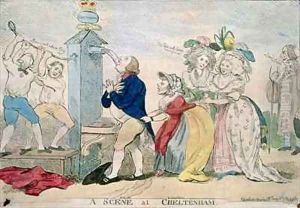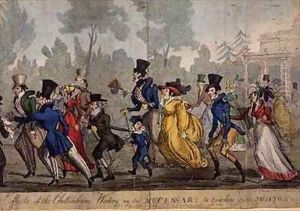S.W. Fores Paintings
Samuel William Fores, commonly known as S.W. Fores, was an English publisher, printseller, and caricaturist, known for his significant contribution to the field of satirical art during the late 18th and early 19th centuries. Born in 1761, Fores established himself in the heart of London's art trade, where he became a central figure in the production and dissemination of satirical prints, which were a popular form of social commentary and political criticism at the time.
Fores opened his print shop at 3 Piccadilly, London, around 1783, and soon his establishment became a hub for prominent artists and caricaturists such as James Gillray, Thomas Rowlandson, and Isaac Cruikshank. These artists often featured prominent figures of the day, including politicians, royalty, and socialites, in exaggerated and humorous situations, and their work was keenly sought after by a public eager for both entertainment and political insight.
In addition to selling single-sheet prints, S.W. Fores also published a variety of macédoines, which were composite works made up of multiple caricatures. His innovative approach to marketing and distribution helped to expand the reach of satirical prints beyond London to a broader audience. Fores was not just a businessman; he also tried his hand at creating caricatures, although his own works did not achieve the same level of fame as those of the artists he patronized.
Despite the often controversial nature of the works he sold, which sometimes led to legal challenges and the threat of censorship, Fores managed to navigate the fine line between satire and libel, allowing his business to thrive. His legacy extends beyond the commercial success of his shop; he played a pivotal role in the development of political and social satire in British art.
S.W. Fores continued to operate his business until his death in 1838. The shop was eventually taken over by his son, who continued the family tradition. Today, the works distributed by Fores are considered important historical documents, reflecting the political climate and social attitudes of the Georgian and Regency eras. They continue to be studied by art historians and are prized by collectors for their wit, artistic skill, and insight into the period.

